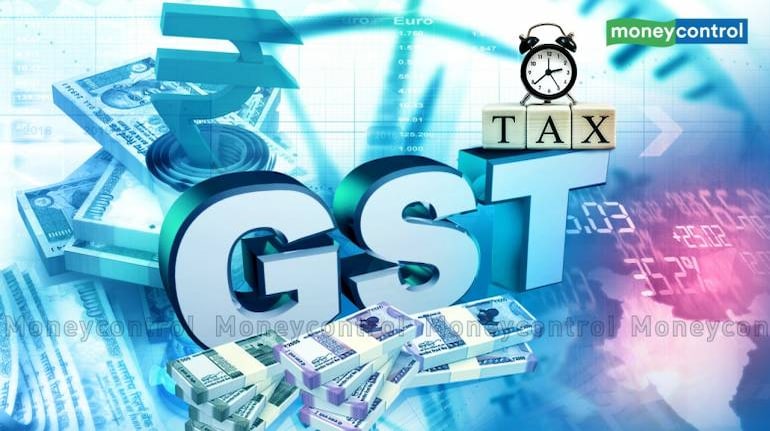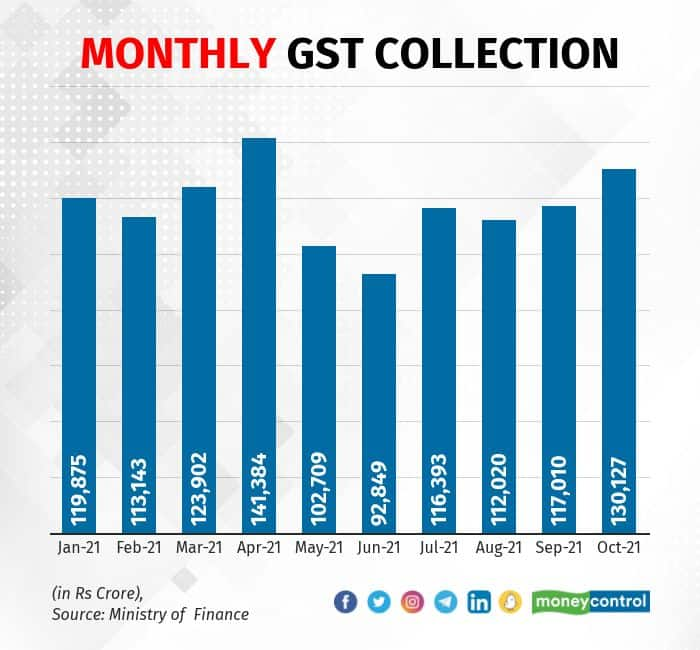



Goods and Service Tax (GST) collections for October, the beginning of a demand-boosting festive season, came in at Rs 1.30 lakh crore, compared with Rs 1.17 lakh crore in September.
October GST collections were not only the second highest for the fiscal year, but the second-highest monthly collections since the introduction of the nationwide tax in 2017. The highest ever was also this year, at Rs Rs 1.41 lakh crore in April. Finance Ministry officials are confident that the Centre’s GST target of Rs 5.30 lakh crore could be exceeded.
With direct tax collections also showing encouraging trends, there is also a view that the net-to-centre total tax target of Rs 15.45 lakh crore is likely to be comfortably exceeded as well.
As the table given below shows, even subdued economic activity due to the Covid-19 second wave could not impact the GST collections, except in the month of June. So far this entire calendar year, GST collections have been above the Rs 1 lakh crore mark in nine out of ten months.
"This is very much in line with the trend in economic recovery. This is also evident from the trend in the e-way bills generated every month since the second wave," the Finance Ministry said in a statement on November 1. "The revenues would have still been higher if the sales of cars and other products had not been affected on account of disruption in supply of semi-conductors," it said.
Moneycontrol explores the reason why GST collections have been so good.

Broad-based economic recovery
The economy has recovered sharply from two waves of the Covid-19 pandemic and even touch services like hospitality and tourism seem to be picking up. As per the latest data points available, most sectors have reached pre-pandemic levels of activity.
India’s manufacturing activity continued to improve in October after setting off on the path to recovery from September onwards as strengthening demand conditions amid the easing of COVID-19 restrictions boosted sales.
According to the monthly IHS Markit India Manufacturing Purchasing Managers’ Index (PMI) survey released on November 1, manufacturing PMI stood at 55.9 in October, up from 53.7 in September and 52.3 in August. Meanwhile, the cumulative output of the core sector industries in the first half of FY22 has risen by 16.6 percent, as compared to a 14.5 percent fall in the same period of the previous financial year.
On the trade front, provisional data for October showed that merchandise exports for the month rose 42.33 per cent year-on-year to $35.47 billion. This was also an increase of 35.21 percent of pre-pandemic October 2019.
There will be more data coming in the middle of the month, including industrial output and vehicle sales. The data over the past ten months, excluding a few months during the second wave, shows that demand and consumption are at or near pre-pandemic levels (if there is revenge tourism, why not revenge consumption?), hence bolstering GST collections
Increased formalisation
In his latest report, State Bank of India Chief Economic Advisor Soumya Kanti Ghosh has said that the size of the informal economy may have shrunk to no more than 20 percent from 52 percent in 2017-18.
Speaking to Moneycontrol, Ghosh said that it is because of increased formalisation that even when the pandemic was at its peak, the GST collections were healthy. “Formalisation is the reason GST collections did not collapse during the pandemic,” he said.
In 2015-16, a survey by the National Statistical Office stated that the total number of unincorporated non-agricultural Micro, Small and Medium Enterprises in the country was around 633.9 lakh. If one goes by data in the GST portal, the number of new MSMEs which were incorporated in the last four years was 499.4 lakh.
Increased formalisation means more companies in the GST net. As Ghosh attests, this is a key reason why GST collections continue to be strong.
Enhanced Compliance Measures
The regular press releases from the Finance Ministry make no bones of the fact that evaders are being monitored using data intelligence from multiple sources. Every week, there are raids on GST evaders across the country. Like here and here.
“In addition to the various measures to streamline return filings, e-way bill generation etc, several restrictions placed on non-compliant taxpayers would also have resulted in many taxpayers gradually becoming more compliant and paying GST and filing returns promptly. Going forward, we may see more checks and balances being introduced to encourage filers and dissuade non-filers,” said MS Mani, Senior Director, Deloitte India.
Looking ahead, Finance Ministry officials expect the GST collections to grow at a steady trot, especially through the festive season of November and December.
Discover the latest Business News, Sensex, and Nifty updates. Obtain Personal Finance insights, tax queries, and expert opinions on Moneycontrol or download the Moneycontrol App to stay updated!
Find the best of Al News in one place, specially curated for you every weekend.
Stay on top of the latest tech trends and biggest startup news.